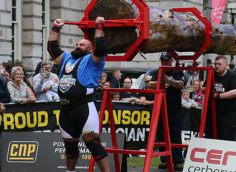Here's what you need to know...
- You cannot improve your deadlift training it only once per week.
- Shut up about imbalances. Life will create imbalances. Your body is pretty smart and can figure most things out on its own.
- Get mentally prepared for each workout. Compete against others. Test yourself.
- Have long term goals and daily goals for each workout.
1 – Deadlift Every Damn Day
A deadlift isn't merely an expression of absolute strength, but a skill-based movement that takes considerable practice to hone and refine.
As such, it's a movement that can be performed daily in order to keep that pattern sharp. It can be in a max or near max modality, a lower intensity version done for a much higher volume, trained for speed, super slow, paused, or with altered stance.
An athlete will train a desired skill for hours each day, in any way possible in order to stay sharp. A deadlift can't conceivably be consistently improved by only training it once a week.
Here's a simple example of how you could work in deadlifting every day, or involve some sort of deadlifting pattern on a regular basis:
- Monday: Max-tension development, using only 135 pounds. Ten sets of 5. Work on getting as tense and braced up as possible. Envision lifting 1,000 pounds and getting set for it. Take as much rest as you need.
- Tuesday: Max speed: Use 60% of your max weight and work on accelerating the weight from the floor to lockout as fast as possible. Do 8 sets of 3 with a 2-4 minute rest between sets. Westside calls this Dynamic Effort. Olympic weight lifters call it a regular training session.
- Wednesday: Near-max lifts. Use 90% of your max and perform 10 singles after working up through a couple of warm-up sets. Take 3-5 minutes of rest between sets.
- Thursday: 20 x 20 kettlebell swings on the minute. Work on getting the hips to snap the movement fast and hard while keeping the core tense and strong.
- Friday: Pause x 2 deadlifts. On the way up, pause for 3 seconds at 3 inches below the knee, 3 inches above the knee, and then finish at lockout. Lower the weight in one move. Use 75% of max for 6 sets of 5. Rest until you can finally see colors again.
- Saturday: Using 85% of your max, do 1 rep every 30 seconds for 10 minutes.
- Sunday: PR day. See what you can manage, but make sure you don't miss the lift.
2 – Get Emotionally Jacked Up
You'll have a significantly better workout by getting mentally prepped before you step onto the weight room floor.
Maybe you have a couple of key motivational words you say to yourself to get into the right mind frame to dominate. Maybe you visualize your end goals, call yourself a pussy, or watch some old training videos of Arnold. Whatever you need to do, do it.
3 – Stick to Your Strengths
"If you're bad at it you should do it more."
I hate everything about this statement. It makes no sense and is so meaningless that it should never be uttered again.
For instance, I'm pretty crappy at doing back bends like a Cirque de Soleil contortionist, so by that logic I should do more of them, even though I might wind up crippled. Maybe I should try to play hockey more even though I can't skate to save my life, or perhaps I should run a marathon, barefoot, against a Kenyan.
Sounds reasonable, doesn't it? These are all terrible, terrible ideas and they will all end badly.
Instead of forcing yourself to endure personal and probably public humiliation from floundering around doing stuff you suck at, why not spend more time getting better at the stuff you're really good at? It's a novel concept, but doing stuff that you're good at tends to leave you feeling happy and more likely to partake in said endeavor again.
If you like it, do it every day. If you don't like it, do it when you have nothing better to do and want to give it a shot. Maybe you just had a bad day last time you tried it. You know, the sun was in your eyes and there was sand in your nether regions. It sucked, so try it again, but don't make it your bread and butter unless you really enjoy it this time.
"But what about imbalances?"
Hey, listen. Shut up. Life will create imbalances. Your body is pretty smart and can figure most things out on its own without spending all day trying to figure out how to get your transverse abdominis turned on.
Have you ever tried to walk around all day without letting your diaphragm descend or your ribs flare, or without winding up slightly into anterior head position? It's exhausting and I don't recommend it. Also, most imbalances are only a problem when they become a problem and require specific interventions to address.
4 – Compete
One of the main reasons why CrossFit continues to be popular is that it simultaneously creates a sense of community and competition. Everyone doing the same workout inevitably breeds competition and even animosity towards your fellow human being. It's paleo.
Endurance activities also seem to breed this type of competitive community thought process. Marathon runners who train alone tend to suffer more when they get into a group setting or a race as they find the pacing difficult, seeing as how it's not their normal speed. Runners who train in groups tend to be competitive with each other, sometimes pushing themselves harder in training than they would in a race.
You could also compete against known standards, much like the CrossFit Open. I know, I just said standards and CrossFit in the same sentence. Sorry, but it's true. If 10,000 people do a workout and their results get tallied and ranked, you can see where you wind up based on your performance, much like an endurance athlete who runs the same course as everyone else.
In short, find a way to compete.
5 – Test Yourself
Tests tend to bring out the best in people. Every now and then I'll throw a surprise test day at my athletes to get them amped up and focused on what they're doing. It could be a cardio test, 1RM test, work capacity test, timed sled sprint series, or some measurable variable that determines their specific capabilities in a movement or load.
Recently, CrossFit did their Open 14.X series, which amounted to tests to see who could complete the most reps or best time at a given activity or series. These were workouts that would make most trainers absolutely cringe if they saw them in someone's program, but the point wasn't for them to be training sessions, but tests to see what people could do.
The kettlebell snatch test in the RKC and SFG certification – 100 reps in 5 minutes with a 24 kilogram bell for men and a 16 kilogram bell for women – is another example. They're not something you want to do on a regular basis, but to see what you can do, once, maybe twice.
There are a lot of standards to measure yourself against to see if you have what it takes. Here are a few:
- 100 kettlebell snatches in 5 minutes.
- Squat and deadlift twice your body weight; bench press 1.5 times your body weight; overhead press your bodyweight.
- Run a 6-minute mile.
- Dan John's 10,000 Kettlebell Swing Workout.
- Back squat your body weight so low that you touch a 4-inch box or yoga block:
6 – Pick a Daily Goal
Long-term goals are great, and they're always important to understand how to make big things happen.
A mortgage is a great example of a long-term goal. Most people can't pay off an entire house in one shot, so chipping away at it one payment at a time is analogous to a workout leading towards an end goal. But each workout should be its own specific entity, and each workout should have its own goals.
You don't have to hit a personal best every workout, but you should have a specific outcome in mind each time you walk through the door. It could be a quantitative outcome such as lifting more weight or increasing the total volume lifted (weight x reps x sets).
Or it could be a qualitative goal such as getting a better catch during a power clean, feeling like you have solid co-contraction through the glutes and abs during your deadlift lockout, or getting a pump through your lats that makes your shirt feel like it's going to split at the seams.
You might, occasionally, have some workouts where you just don't have any energy or will to get after it, and that's fine too. These workouts can be devoted to recovery, breathing techniques, foam rolling, or trying something new and funky that wouldn't normally be part of your workouts.
7 – Train with a Plan
Going to the gym and just expecting to wing it never produces the kind of benefits you're looking for. Having a plan keeps you on point and lets you focus on just the workout and not on any of the sideshows running around in the gym.
It could be as simple as writing things out on a Post-It note before you head into the gym, or you could use a logbook to track how you're progressing.
8 – Ratchet Up Intensity
Intensity is as much a mindset as a quantitative expression. Most people view intensity as just adding more weight to the bar, but to move that weight you have to get your mind right. If the weight is relatively light, lift it hard and fast and see how much more tension you can develop through the entire body to help move the weight faster and more violently.
If the weight is heavy, get jacked up to a level of uncomfortable energy that will make small children cry and large women quake when they see you get after it. I'm not talking about getting to the point where you're getting kicked out of a Planet Fitness, but get excited and lift with some emotion, dammit! You need to occasionally get to a state of blind rage in order to see significant strength gains.
If maximum-weight lifts aren't your thing, try to double the volume of your workouts through either increasing your number of sets or the number of reps, and try to do the workout in the same amount of time.
For instance, let's say you're doing a squat-focused day and you usually do 5 sets of 8 reps, taking 4 minutes of rest between sets, and the whole thing takes 25 minutes. Try to perform a workout of 10 sets of 8 within the same timeframe.
9 – Find a Workout Partner
This one is often overlooked due to convenience, or lack of it. Sure, it's always easier to work out on your own, and scheduling someone else to come to the gym with you could act as an obstacle, but it doesn't have to be that complicated.

Each gym has its regulars who always show up at specific times of the day, simply because that's when they have the time to train. You can find others in the gym that train at the same time as you and then strike up a conversation with them.
There's no one who can push themselves as hard on their own as they could with someone else right beside them, urging them on and monitoring rest time. This is one reason why training in groups or in teams is so effective.
There's nothing like the atmosphere of a hard practice where everyone is jacked up and busting their butts to outwork each other.





